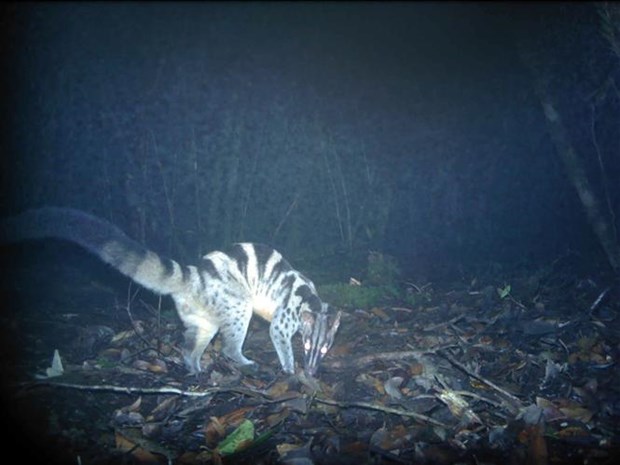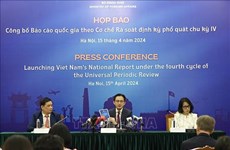Endangered animals found in Bidoup-Nui Ba National Park
A range of rare and endangered animal species in Vietnam and the world were discovered at the Bidoup-Nui Ba National Park in the central highlands province of Lam Dong through a camera-trap survey on the site from October 2019 to March 2020.
 The image of a civet (Chrotogale owstoni) captured by camera traps (Photo: VNA)
The image of a civet (Chrotogale owstoni) captured by camera traps (Photo: VNA)Lam Dong (VNA) - A range of rare and endangered animal species in Vietnam and the world were discovered at the Bidoup-Nui Ba National Park in the central highlands province of Lam Dong through a camera-trap survey on the site from October 2019 to March 2020.
According to national park director Dr Le Van Huong, the survey was jointly carried out by the park’s management board, the Southern Institute of Ecology, and the Leibniz Institute for Zoo and Wildlife Research (Leibniz - IZW) from Germany.
The survey initially found that the park had a very high diversity of mammals, with at least 21 rare and precious species, including seven globally-threatened ones.
The most important discovery was the existence of a large muntjac (Muntiacus vuquangensis), a ungulate that can only be found in the Truong Son Mountain Range (which runs from Vietnam’s north down to Lam Dong) and is featured on the International Union for Conservation of Nature (IUCN) Red List of Critically Endangered (CR) Species. Conservationists believe the species is indeed extinct in most forests in Vietnam.
Meanwhile, the most surprising finding was the existence of an albino porcupine which had previously never been known in Southeast Asia’s natural forests.
Camera traps also captured images of some susceptible endemic species, including a civet (Chrotogale owstoni) and sun bears (Helarctos malayanus), which are nearing extinction due to illegal hunting.
Nguyen The Truong An, field coordinator with Leibniz-IZW, said the national park is one of just a few nature reserves in Vietnam to be home to the civet.
Its presence and that of the sun bears shows that Bidoup-Nui Ba National Park has not overly suffered from hunting compared to other forests along the Truong Son Mountain Range, he said.
The survey aimed to explore the diversity of birds and mammals and develop a monitoring programme that could assess the status and population dynamics of endangered species.
The second phase is being implemented from April to August, with about 120 locations surveyed.
Covering an area of 34,943 ha, the Bidoup-Nui Ba National Park is the core area of the Langbiang Biosphere Reserve, which was recognised by UNESCO in June 2015./.













